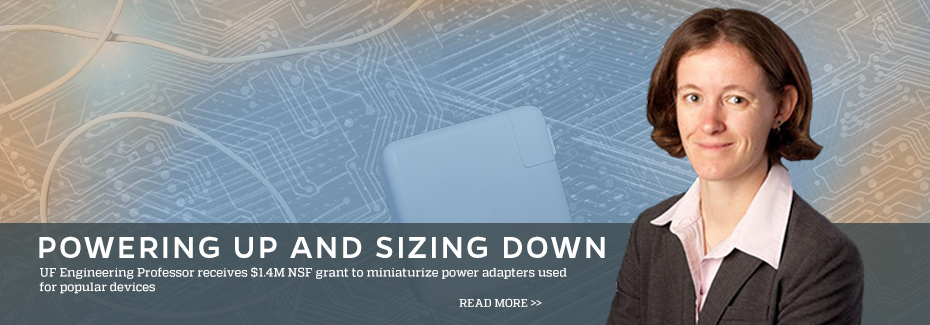While our phones and computers are significantly smaller than they were 10 years ago, the power adapters for those devices have only seen modest changes in terms of size.
Jennifer Andrew, Ph.D., associate professor, and her collaborators, Carlos Rinaldi, Ph.D., Charles A. Stokes Term Professor and Interim Chair in UF’s Chemical Engineering Department, and David Arnold, Ph.D., the George Kirkland Engineering Leadership Professor in UF’s Department of Electrical and Computer Engineering, want to know if big power can come in smaller packages. All three are faculty at the Herbert Wertheim College of Engineering.
Andrew and her team received a $1.4 million grant from the National Science Foundation (NSF) to study scalable and high-performance magnetic materials that can be implemented into modern-day devices that would take up less space.
Approximately 20 to 40 percent of the circuit board area of a smartphone is dedicated to power conversion and management.
“The miniaturization of these components has been limited by the magnetic materials available,” Andrew said. “The goal of this project is to develop new synthetic and nanomanufacturing processes that overcome existing challenges while affording breakthrough high-frequency magnetic performance and allowing miniaturization of these critical power components.”
The primary existing challenge for this project is the lack of materials that provide the appropriate performance at small scales. To make a magnetic core smaller, the material used for the core must have high magnetic permeability and be electrically insulating to minimize loss.
Currently, materials with high magnetic permeability, which means they are easier to magnetize, tend to be metals. Metals conduct electricity instead of being insulated, which results in large losses. Oxide-based or electrically insulating magnetic materials have relatively low magnetic saturations but only modest magnetic permeabilities.
The aim is to research and develop materials that exhibit high magnetic saturation and low loss to ensure that despite the smaller size of the material, it can hold as much, if not more, energy than previous larger magnetic cores.
This will be accomplished by fabricating nanocomposites that combine the beneficial properties of the metal-based magnets with those of the oxide-based magnets.
This research will delve into creating compact power inductors and transformers that are compatible with current manufacturing standards, including using existing silicon wafers and circuit boards.
The success of this project will require leveraging the unique properties of magnetic materials at the nanoscale and an interdisciplinary engineering team.
Andrew, Rinaldi and Arnold have previously worked together on projects. Still, the shift in the NSF grant for integrated systems presented a synergistic opportunity to combine Rinaldi’s research in novel synthesis, Arnold’s application development, and Andrew’s research in developing nanocomposite-based magnetic materials.
“The collaboration between our three departments really allows the complete realization from synthesis, characterization, and processing through to the final device,” Andrew said.
In addition to faculty, this project will include graduate students from all three disciplines.
“[The NSF grant] allows my graduate students to gain access to not just the resources within the materials science discipline but exposes them to a wide range of fields and resources across campus,” Andrew said. “I think these multi-PI programs are great not just for the funded project but can also serve as a catalyst for new projects and ideas.”
The potential outcome will be the development of new magnetic materials that are scalable to smaller sizes. This could disrupt and change a $12 billion industry that uses magnetic structures and components.
The benefit of this research for everyday people is that it will allow them to finally see the size of their laptop chargers get smaller and, likely, further miniaturization of their devices as the space dedicated to power management decreases.
